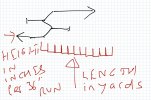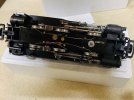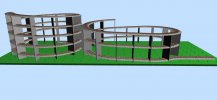So, if I understand correctly, a "rack" system is a cog line - uses teeth to lock in as it moves forward. That would make much more sense. Never considered it. Have a feeling I know the answer, but going to ask anyway: is there a way to combine these 2 systems? Assuming rack uses specialized track - can it be used to replace sections of regular track. Can regular loco's/cars be modified to run on both?
If I worked it out correctly (thank you dunnyrail), I can make a 2 1/2 ft incline over 15 feet. However, I pushed the grade to 4-5% and only have about 2 1/2 ft on the "tails." Given loco is 22.5 inch, not very useful. I used about 9ft for each run to gain elevation. I guess that could be decreased and add more zig zags and decrease grade - what a pain in the butt, I need a cog








